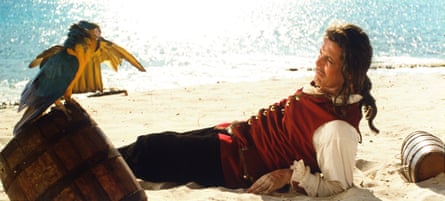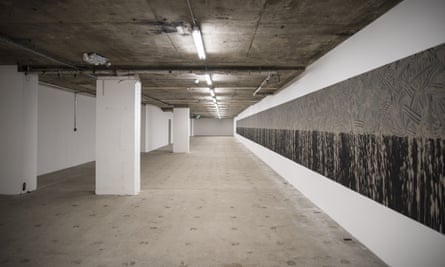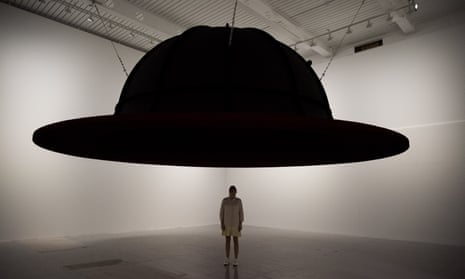A white line snakes through the spaces of Store Studios, housed in a 1971 brutalist office block on the Strand. Painted using one of those wheeled contraptions that mark out football pitches and sports fields, the line trundles from under a closed lift door, makes its way splashily up a swanky staircase – passing a Lawrence Weiner work that repeats the same phrase, “WHOLE CLOTH STRETCHED TO THE LIMIT”, on the wall in big letters on every level – makes arcing oxbow detours across the concrete floors, and comes to a stop, where the machine ran out of paint, on the first floor. There it stands. Phew. Ceal Floyer’s Taking a Line for a Walk follows Paul Klee’s famous definition of drawing. Floyer’s work is a nice detour in a show of 24 Lisson Gallery artists that doesn’t try too hard to make any sense at all.
I looked for a theme but there wasn’t one, apart from the fact that all the artists show with the gallery, now celebrating its 50th year. From Dan Graham, who first showed at Lisson in 1972, to Turner prize winner Laure Prouvost, who joined this year, it is just everything at once, and one damn thing after another, in a group show whose title comes from a 1966 quotation by John Cage. “Nowadays everything happens at once and our souls are conveniently electronic (omniattentive),’ Cage wrote, presciently. He should have tried 2017. Attentiveness is difficult. Everything at Once is a portmanteau conceit, unlike the Hayward’s excellent offsite film and video project The Infinite Mix, which occupied the same building in 2016.
Neither a medium nor a message connects the works here. There is Ai Weiwei’s iron-cast tree-trunk and tangled roots painted gold, and a room devoted to what looks like a gigantic bowler hat, by Anish Kapoor, that hangs above our heads. Or maybe it’s a 1950s flying saucer. Standing under the crown, the interior dome is a deep, dark red, threatening to suck us back up into some sort of cosmic womb.

I ran out, in search of Rodney Graham’s shipwrecked sailor, stranded on a tropical island with a parrot, who repeatedly gets concussed by a falling coconut in Graham’s 1997 film loop Vexation Island. After all these years, I still wince every time the nut knocks Graham out. Time has been less kind to some other works here.
Much, much later in the show we come to a series of paintings by American painter Stanley Whitney. Now in his 70s, Whitney makes every colour in his abstractions of bars and rectangles glow and sing and jump. Like a sax player, he also makes the breathy slurs and delays count. At once casual and precise, Whitney shows us how fickle painterly relationships are, and how all colours can get along with one another if they’re painted right. A rare moment of visceral, optical pleasure, Whitney’s canvases have a great, light touch.
On a wall that runs the breadth of the building, Richard Long tries to keep the tempo up in his mud drawing. It goes on and on and on and on some more, his fingers pawing at the mud, the mud dripping. I keep running out of steam. In three videos by Marina Abramović (two from 1975, another from a decade later), she tests her own endurance and ours. And that of the bongo player who accompanies her naked solo dance, masked. In another performance video she tries to remember Serbian words (“Red carpet … rhomboid … monotonous”), and in a third she lies on the floor with her head tilted backwards and screams till she loses her voice.

Shall we never scream again? Of course we shall, but will anyone hear? Have I died already? Susan Hiller has recorded anecdotes of near-death experiences. When I go towards the light, I hope never to come back. I hope I don’t find Kapoor’s throbbing red womb on the other side, or the pulsating blips and glows and rainbows of Nathalie Djurberg and Hans Berg’s recent video installation. Whatever has happened to Djurberg’s work, which used to be full of foolish wisdom and hilarious stop-motion animated action? Wherever she is going in her recent collaborations with Hans Berg, I cannot follow.
Better to escape altogether on to the roof, where, in one of several other projects at Store presented with the Vinyl Factory (in this case, a co-presentation with the Serpentine Gallery), Arthur Jafa shows Love Is the Message, the Message Is Death, a gritty compilation of found footage – Jimi Hendrix and James Brown, LA Riots, brutal beatings and shootings, the inequalities and racism of America – set to Kanye West’s brilliant, gospel-inspired Ultralight Beam. Seven minutes long, Jafa’s work is the timeliest thing in the building, condensing time, place and history, giving us it all at once. It is worth the trip alone.

Comments (…)
Sign in or create your Guardian account to join the discussion